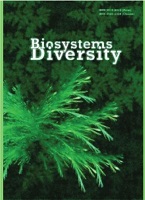Heavy metal accumulation by Acer platanoides and Robinia pseudoacacia in an industrial city (Northern Steppe of Ukraine)
Heavy metal accumulation by Acer platanoides and Robinia pseudoacacia in an industrial city (Northern Steppe of Ukraine)
Author(s): V. M. Lovynska, K. Holoborodko, I. Ivanko, S. Sytnyk, O. Zhukov, I. Loza, O. Wiche, H. HeilmeierSubject(s): Energy and Environmental Studies, Environmental Geography, Health and medicine and law, Rural and urban sociology, Environmental interactions
Published by: Дніпропетровський національний університет імені Олеся Гончара
Keywords: heavy metals; urban systems;leaves; bioaccumulation coefficient;Robinia pseudoacacia;Acer platanoides;
Summary/Abstract: The role of tree species as a tool for bioaccumulation of heavy metals is an important current issue within the context of the increase of anthropogenic pressure in urban ecosystems. The article presents the results of research on the level of soil contamination with heavy metals and the processes of their accumulation by native and introduced tree species in green spaces of Dnipro city. Inductively coupled plasma mass spectrometry (ICP-MS) was used to detect concentrations of heavy metals (Zn, Cu, Cd, Pb) in soil samples and the assimilation component in trees of black locust (Robinia pseudoacacia) and Norway maple (Acer platanoides). The ranges of mean concentrations of heavy metals at different study sites within the city’s green infrastructure were as follows (mg/kg): 30.7–185.5 for Zn, 5.7–22.4 for Cu, 9.0–31.3 for Pb, and 0.213–0.598 for Cd. With respect to all four of these metals, the soils of the Metallurgists Square location were characterized by the highest concentrations of the metals, and the Pridneprovsky Park in the area of the outskirts of Dnipro city was characterized by the lowest ones. Compared to soils, the two investigated tree species had a significantly lower content of all studied metals in leaves. The heavy metal accumulations in the leaves of both R. pseudoacacia and A. platanoides were observed in the following decreasing order: Zn > Cu > Pb > Cd. Regarding the migration of heavy metals in the soil-plant system, the concentrations of ecopollutants in the plants were found not to be dependent on their content in the soil environment. The calculated bioaccumulation coefficients of heavy metals for both tree species were less than 1. However, the results of heavy metal concentration in leaves of both introduced and native tree species evidenced their special role in heavy metal bioaccumulation. Compared to R. pseudoacacia,such native species as A. platanoides can be considered to be a more “sensitive” bioindicator of environmental pollution caused by heavy metals. Planting fastgrowing tree species such as R. pseudoacacia and A. platanoides can in a short time be an environmentally appropriate and cost-effective measure to mitigate the unfavourable effects of heavy metals on the environment.
Journal: Biosystems Diversity
- Issue Year: 31/2023
- Issue No: 2
- Page Range: 246-253
- Page Count: 8
- Language: English

